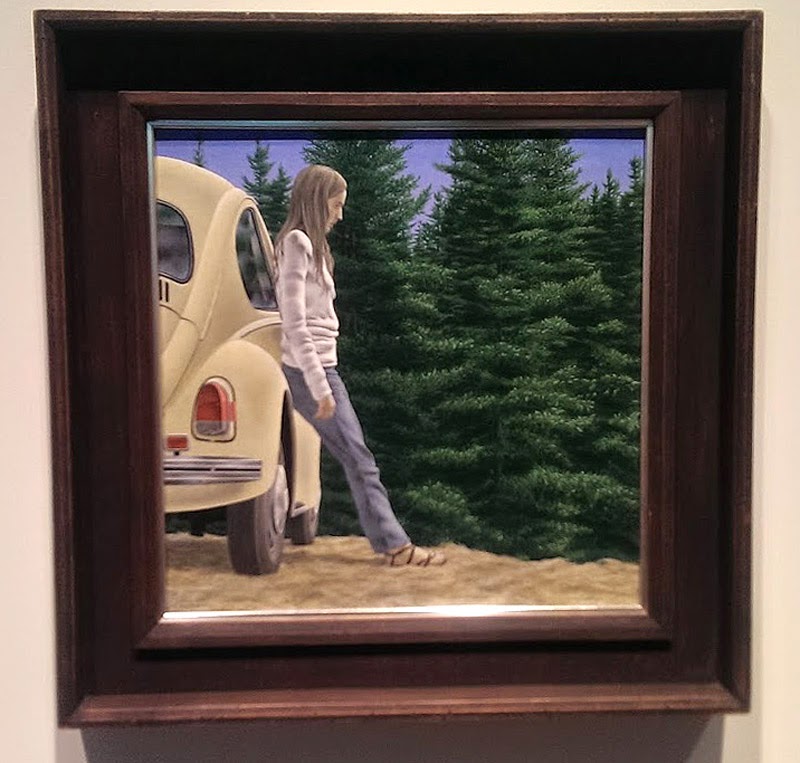I HAVE BEEN A BIG FAN OF ALEX COLVILLE for some years now. It might be that, as a photographer, I find it easier to access his very realistic (but hardly "photo-realistic") aesthetic than less figurative painters. It might be that he's among the most Canadian of painters, and I've finally gotten tired of rebelling against intrinsically Canadian art. But when I went to see a retrospective of his work at the Art Gallery of Ontario the other day, it occurred to me that there might be another reason - one that I've overlooked until now.
The man really loved cars.
The painting above is called "Artist with Car" - a self-portrait, I presume, of Colville with a late-model BMW-era Mini, in front of the sort of monstrous snow drift that any Canadian will recognize with a shiver in their heart. In the notes posted on the wall of the exhibition, a curator noted that Colville did love his cars, priding himself in his make-and-model "car-spotting" as a boy, and taking a particular relish in "German performance" when, as a successful artist, he could spend some money on a vehicle.
I'm not exactly sure how this theoretically British hatchback designed by Germans fits that bill, but I'll just put it down to an older driver settling for a more sensible (but not inexpensive) car out of prudence. I'll just have to hope that Colville had a history of well-sorted BMW 2002s and Mercedes Benz 280s in his past.
Here's another later painting. German engineering, to be sure.
I can only hope the Smart Car was a rental.
Of course, any man who really loves cars also loves racing, so it gladdened my heart to see this portrait of a race car driver from the "gentleman's bloodsport" era of motorsport, behind the massive steering wheel of a front-engined grand prix car, unencumbered by seat belts or a helmet that offers anything but notional protection.
It has to be noted that Colville took great care to get the details of his cars right - no shapeless wheeled blobs with vaguely sketched-in bumpers and headlights here, but anatomically correct vehicles, like this old VW bug, car of choice for the sort of young woman who'd end up leaning against the passenger side of the car at a rest stop on some wearying cross-country road trip with her boyfriend. Or at least that's the backstory I can't help but invest in this painting - a scene that looks impeccably (and depressingly) '70s to my eyes.
Here's another Bug - the sleeker but somehow less soulful New Bug, with its arched windows and unsentimentally retro lines, contrasted against the wheeled fortress of a Brinks van in the in the background. I'll assume that's his wife behind the wheel - his long-suffering model - and one of his family's many dogs in the back, being impassively chauffeured into town. Once again - German engineering, but of a more sensible, sedate variety.
We're back to the '70s again - or perhaps the early '80s; the transition was hard to define in some places - with this painting of a small town war memorial under gray winter skies, where the only splash of colour is provided by a Renault 5, sold over here as the cloyingly cute Le Car. A French car in a Canadian town, many miles and years away from the French fields where Canadians died. A moment to pause and reflect, to be sure.
What I love about Colville is these glimpses, like the one above - the woman (young? older? - it's hard to tell) looking a bit overdressed in her fur and heels next to the Western Star truck at night, posing for the camera of a shadowy man dressed for work. If there's menace or seediness in the scene, we have to admit after examining our reaction that it's probably mostly in our minds.
(As a sidenote, the Western Star is tangentially a piece of German engineering as well, as the company is now a division of Daimler.)
Finally there's another self-portrait of artist as an older man - Colville and his wife, in "Kiss with Honda." It looks like a fourth-generation Civic - another very sensible car, especially if you're dealing with snow and rural roads. With its missing hubcaps and bare steelies, it would be the second car - the one you take in to pick up shopping or the mail on days when the skies look unfriendly.
It was painted in 1989, apparently, and even though Colville died just last year, it feels elegaic. It's twilight and the man is setting off on a journey with his lights on, heading into the dark, the car a very understated funeral bier. The kiss from his life's companion feels like a more than perfunctory goodbye - but maybe that's just me reading my own preoccupations into it. You're supposed to do that with Colville's paintings, I think.
But part of me just wishes it wasn't a Civic. A Mercedes SL, or an S-class. That would be the way to go. But that wouldn't be very Canadian.








